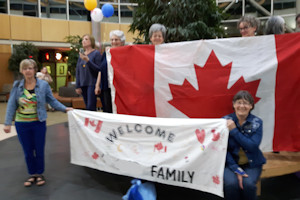 How exciting that finally after months or years of planning & preparation, the time has arrived to meet the family at the airport.
How exciting that finally after months or years of planning & preparation, the time has arrived to meet the family at the airport.
The SAH will have received and forwarded to the CG the Notice of Arrival Transmission (NAT) from IRCC about 10 days prior which includes the refugee(s) specific travel itinerary, the names, birthdates, and gender of family members. The NAT notification also includes languages spoken, any medical needs that have been identified, if there are family/friends of the PA already in Canada, and of course the SAH and CG details.
It is important at this stage to double-check the spelling of names and accuracy of birthdates on the NAT. Errors happen, and the information included on the NAT is the information that will get used for the Permanent Resident paperwork and subsequently other Government issued ID.
If you see errors, contact your SAH who will then contact ROC-O on your behalf.
The SAH will also request the temporary or permanent address of the newcomers. If permanent housing has not been secured, use the address of someone in the sponsoring group if the temporary housing is not private. (i.e. a hotel). Having a Canadian address to give CBSA on arrival in Canada will speed up the process of getting the Permanent Resident card of everyone in the family.
Preparing for Arrival:
- In most cases, only a few members of the group should greet the newcomers at the airport.
- Be aware that while sponsors may feel excited and eager, the newcomers may be overwhelmed, nervous, and exhausted after a long trip.
- Arrange for an interpreter if necessary.
- Be prepared:
- Do you need car/booster seats?
- Do you have enough room for everyone and luggage?
- Usually newcomers arrive with at least one suitcase each.
 At the Airport:
At the Airport:
- Bring a welcome sign with you to the airport, with "Welcome" in English and their language (if possible). Be careful using the family's name. If photos are posted on-line, their name will be public to everyone.
- Check the flight status online before you leave.
- Be prepared to wait 1-3 hours after the time of arrival, as newcomers go through immigration. They will exit the international arrivals area (unless there is a domestic connection).
- Newcomers are escorted through immigration and out to their sponsors. A sponsor group member will be asked to sign a confirmation document (any member can sign).
- Introduce yourselves to the newcomers, explain that you are part of a volunteer group that will support them in Canada and that you will explain more over the next few days.
Arriving Home:
- Avoid separating parents and children on the way home, if this is not possible; make sure that you have the parents’ agreement.
- Ensure newcomers have immediate access to internet (and a device through which to access it, even if it is temporary).
- Do a basic orientation to the home and area. Remember they are probably exhausted and need to rest.
- Provide a phone card if they wish to communicate to family overseas via telephone.
- Arrange a time to return.
Pictures:
- If you want to take pictures, always ask first. Use your best judgement and do not take pictures if newcomers seem uncomfortable.
- If they want to be in pictures, only take a few to make the process quick. This applies throughout the entire sponsorship.
Address Notification - PR Card:
- If it was not possible to provide an address prior to arrival, newcomers will receive an Address Notification form.
- The sponsor group should ensure this form is completed and submitted to the PR Card Processing Centre as soon as possible or update the address online.
Important Documents:
Newcomers will receive the following documents upon arrival at the airport:
- Confirmation of Permanent Residence: 1 paper document per person, serves as their principal proof of immigration status. The Permanent Residence (PR) Card will be mailed to the address provided by the SAH or the newcomers.
- Interim Federal Health Program (IFHP): 1 paper document per person.
- Passport or Travel/Single Journey Document: used to travel to Canada.